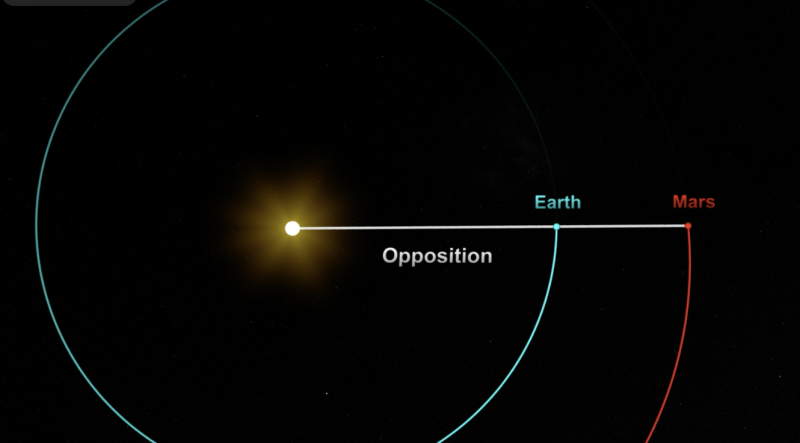Ready to see Mars at its very best? This is the most special Martian week until the mid-2030s. Mars reached its closest and brightest on December 1 and still retains its incredible dazzle. It will meet the full Moon on Wednesday, December 7—the same night that it’s at opposition, opposite the Sun in our sky.
Advertisement
You’ve probably already noticed it. It’s the second-brightest “star” in the whole sky (bested only by white Jupiter) and it’s as orange as the fruit. Plus, it’s out all night, so no need to set any alarm. But if you care to observe it just once, choose Wednesday, December 7.
Mars Opposition, December 7–8
In North America, the night of December 7-8 is the date of the Mars opposition, which only happens every 2 years. Earth passes between Mars and the Sun, with Mars and the Sun on opposite sides of the sky. It’s as close as the two planets can get, with Mars shining at its brightest. You can really notice Mars’ distinct orange hue, which is caused by oxidized iron on its dusty surface.

The Moon Occults Mars
Mars rises at sunset and into the early evening, accompanied by the full Moon, also at opposition this night. At around 10:30 to 11 PM in the eastern evening sky, Mars will hover so close to the Full Moon that it’ll essentially be touching its edge.
Those in the northern US and all of Canada will even see the Moon occult Mars—pass in front of it, blocking it out entirely. A planet occultation is very rare! It’s something that happens only a few times in your life, and one that occurs when the planet’s at its closest and brightest? Don’t miss it.
How to Observe the Mars Opposition
Mars is so bright that you don’t even need rural, unpolluted skies. A city street, a rooftop—heck, it’ll even be a standout from brilliantly lit prison yards! (This may seem a strange example, but I actually taught astronomy at a maximum security prison for four years, to specially selected inmates trying to earn a college degree.)
If you have any backyard telescope, point it at Mars on a night when the stars aren’t twinkling and it’s not windy. Those are signs that the air may have an even temperature, which allows sharp imagery. Then you’ll easily see the northern Martian polar cap and some of its dark surface markings.
More Martian Facts
But if all you have are your baby yellows (if you’re a cat or else Data from Star Trek), here are some basic Martian facts that go nicely with its eye-catching presence.
- Earth meets and passes Mars every 26 months. At such times, Mars can come as close as 34 million miles, which it does if Earth meets it on August 28, which happened in 2003. This time around, our meeting occurs with Mars 50 million miles away, which is still close and won’t be equaled until 2033. If you’re young enough to plan ahead a quarter century, we’ll have future super-close meetings in 2035 and 2050, with Mars at its very closest within a fortnight of late August.
- Mars is called the Red Planet, but it’s not red. The color you see in the night sky—that’s it’s real hue. Up close, spacecraft see its surface as a kind of mocha brown or tannish.
- With a 4,000 mile diameter, Mars has half of Earth’s width. But it boasts our same land area, when you subtract all of our planet’s oceans.
- People often talk of having colonies there. But realists know that it’s a fairly high-radiation place with no breathable air. Its atmosphere is 100% carbon dioxide with a pressure just one percent of ours. You can’t breathe there. But the “colonization” talk never stops because no other planet is even possible. Mercury and Venus are way too hot, and all the others are gaseous, with no surface to land on. So it’s Mars or nothing, so far as planets are concerned. The solution might be living underground there, as unpleasant as that sounds to this writer.
- Mars is now at the most northerly part of the zodiac, sitting at the Taurus-Gemini border. That means that at midnight it’s close to straight up. It’s then three sun widths or moon-widths higher up than the Sun stands at midday on the summer solstice!
Bottom-line: On Wednesday night, the 7th of December, just around midnight, the Moon/Mars combination will be in that virtually-at-the-zenith position. If your neck can handle it, it’ll be a sight to remember!

Photo: WE are sometimes more of a “Red Planet” than Mars, especially as seen in this autumn Adirondacks photo taken by this author.

Comments